Energy Vulnerability Composite Index in Social Housing, from a Household Energy Poverty Perspective
Abstract
:1. Introduction
2. Background
3. Methodology
- The dwelling characteristics of the home.
- The performance of the energy installations.
- The cost of energy.
- The characteristics and habits of household members.
- Directly measuring household energy consumption (heating, lighting, refrigeration, etc.) and comparing it to a given standard.
- Analysing variations in energy consumption profiles across the consumer population, both in relative and absolute terms.
- Compiling subjective perceptions of household energy consumption and supply.
4. Case Study
- Dwell 1: Geographical area in which the building is located.
- Dwell 2: Environment where the building is located (urban/rural).
- Dwell 3: Year of construction of the building.
- Dwell 4: Ownership.
- Dwell 5: Type of residence.
- Dwell 6: Size.
- Dwell 7: Number of rooms.
5. Conclusions
Acknowledgments
Author Contributions
Conflicts of Interest
References
- Khandker, S.R.; Barnes, D.F.; Samad, H.A. Are the energy poor also income poor? Evidence from India. Energy Policy 2012, 47, 1–12. [Google Scholar] [CrossRef]
- Jones, R.H. OECD/EIAEnergy Poverty: How to Make Modern Energy Access Universal? Special Early Excerpt of the World Energy Outlook 2010. Available online: http://www.worldenergyoutlook.org/media/weowebsite/2010/weo2010_poverty.pdf (accessed on 24 April 2017).
- Bouzarovski, S.; Petrova, S. A global perspective on domestic energy deprivation: Overcoming the energy poverty-fuel poverty binary. Energy Res. Soc. Sci. 2015, 10, 31–40. [Google Scholar] [CrossRef]
- Teller-Elsberg, J.; Sovacool, B.; Smith, T.; Laine, E. Fuel poverty, excess winter deaths, and energy costs in vermont: Burdensome for whom? Energy Policy 2016, 90, 81–91. [Google Scholar] [CrossRef]
- Roberts, S. Energy, equity and the future of the fuel poor. Energy Policy 2008, 36, 4471–4474. [Google Scholar] [CrossRef]
- Dubois, U.; Meier, H. Energy affordability and energy inequality in Europe: Implications for policymaking. Energy Res. Soc. Sci. 2015, 18, 21–35. [Google Scholar] [CrossRef]
- Bouzarovski, S. Energy poverty in the European Union: Landscapes of vulnerability. Wiley Interdiscip. Rev. Energy Environ. 2014, 3, 276–289. [Google Scholar] [CrossRef]
- Brunner, K.M.; Spitzer, M.; Christanell, A. Experiencing fuel poverty. Coping strategies of low-income households in Vienna/Austria. Energy Policy 2012, 49, 53–59. [Google Scholar] [CrossRef]
- Darby, S.J. Metering: EU policy and implications for fuel poor households. Energy Policy 2012, 49, 98–106. [Google Scholar] [CrossRef]
- Thomson, H.; Snell, C. Energy Poverty in the EU. Available online: http://fuelpoverty.eu/wp-content/uploads/2013/06/Final-energy-poverty-policy-brief-EU-Energy-Week-13.pdf (accessed on 24 April 2017).
- Thomson, H.; Snell, C. Quantifying the prevalence of fuel poverty across the European Union. Energy Policy 2013, 52, 563–572. [Google Scholar] [CrossRef]
- Santamouris, M.; Paravantis, J.A; Founda, D.; Kolokotsa, D.; Michalakakou, P.; Papadopoulos, A.M.; Kontoulis, N.; Tzavali, A.; Stigka, E.K.; Ioannidis, Z.; et al. Financial crisis and energy consumption: A household survey in Greece. Energy Build. 2013, 65, 477–487. [Google Scholar] [CrossRef]
- Santamouris, M.; Kolokotsa, D. On the impact of urban overheating and extreme climatic conditions on housing, energy, comfort and environmental quality of vulnerable population in Europe. Energy Build. 2015, 98, 125–133. [Google Scholar] [CrossRef]
- Atsalis, A.; Mirasgedis, S.; Tourkolias, C.; Diakoulaki, D. Fuel poverty in Greece: Quantitative analysis and implications for policy. Energy Build. 2016, 131, 87–98. [Google Scholar] [CrossRef]
- Liddell, C.; Morris, C. Fuel poverty and human health: A review of recent evidence. Energy Policy 2010, 38, 2987–2997. [Google Scholar] [CrossRef]
- Rudge, J.; Gilchrist, R. Measuring the health impact of temperatures in dwellings: Investigating excess winter morbidity and cold homes in the London Borough of Newham. Energy Build. 2007, 39, 847–858. [Google Scholar] [CrossRef]
- Walker, R.; Liddell, C.; McKenzie, P.; Morris, C.; Lagdon, S. Fuel poverty in Northern Ireland: Humanizing the plight of vulnerable households. Energy Res. Soc. Sci. 2014, 4, 89–99. [Google Scholar] [CrossRef]
- Patterson, J.; Louise, J. Evaluation of a regional retrofit programme to upgrade existing housing stock to reduce carbon emissions, fuel poverty and support the local supply chain. Sustainability 2016, 8, 1261. [Google Scholar] [CrossRef]
- Healy, J.D.; Clinch, J.P. Fuel poverty, thermal comfort and occupancy: Results of a national household-survey in Ireland. Appl. Energy 2002, 73, 329–343. [Google Scholar] [CrossRef]
- Herrero, S.T.; Bouzarovski, S. Energy Transitions and Regional Inequalities in Energy Poverty Trends: Exploring the EU Energy Divide. 2015, pp. 1–45. Available online: https://www.researchgate.net/profile/Sergio_Tirado-Herrero/publication/273896621_Energy_Transitions_and_Regional_Inequalities_in_Energy_Poverty_Trends_Exploring_the_EU_Energy_Divide/links/55100c060cf2ac2905afb4b1.pdf (accessed on 24 April 2017). [CrossRef]
- Papada, L.; Kaliampakos, D. Measuring energy poverty in Greece. Energy Policy 2016, 94, 157–165. [Google Scholar] [CrossRef]
- Elsharkawy, H.; Rutherford, P. Retrofitting social housing in the UK: Home energy use and performance in a pre-Community Energy Saving Programme (CESP). Energy Build. 2015, 88, 25–33. [Google Scholar] [CrossRef]
- Desogus, G.; di Pilla, L.; Mura, S.; Pisano, G.L.; Ricciu, R. Economic efficiency of social housing thermal upgrade in Mediterranean climate. Energy Build. 2013, 57, 354–360. [Google Scholar] [CrossRef]
- Belpoliti, V.; Bizzarri, G. A parametric method to assess the energy performance of the social housing stock and simulate suitable retrofit scenarios: An Italian case study. Energy Build. 2015, 96, 261–271. [Google Scholar] [CrossRef]
- Alonso, C.; Oteiza, I.; García-Navarro, J.; Martín-Consuegra, F. Energy consumption to cool and heat experimental modules for the energy refurbishment of façades. Three case studies in Madrid. Energy Build. 2016, 126, 252–262. [Google Scholar] [CrossRef]
- Filippidou, F.; Nieboer, N.; Visscher, H. Energy efficiency measures implemented in the Dutch non-profit housing sector. Energy Build. 2016, 132, 107–116. [Google Scholar] [CrossRef]
- Giglio, T.; Lamberts, R. Savings related to solar water heating system: A case study of low-income families in Brazil. Energy Build. 2016, 130, 434–442. [Google Scholar] [CrossRef]
- Burgas, L.; Melendez, J.; Colomer, J.; Massana, J.; Pous, C. Multivariate statistical monitoring of buildings. Case study: Energy monitoring of a social housing building. Energy Build. 2015, 103, 338–351. [Google Scholar] [CrossRef]
- Bahaj, A.S.; James, P.A.B. Urban energy generation: The added value of photovoltaics in social housing. Renew. Sustain. Energy Rev. 2007, 11, 2121–2136. [Google Scholar] [CrossRef]
- Sdei, A.; Gloriant, F.; Tittelein, P.; Lassue, S.; Hanna, P.; Beslay, C.; Gournet, R.; McEvoy, M. Social housing retrofit strategies in England and France: A parametric and behavioural analysis. Energy Res. Soc. Sci. 2015, 10, 62–71. [Google Scholar] [CrossRef]
- Terés, -Z.J.; Martín, K.; Erkoreka, A.; Sala, J.M. Field assessment of thermal behaviour of social housing apartments in Bilbao, Northern Spain. Energy Build. 2013, 67, 118–135. [Google Scholar]
- Jenkins, D.P. The value of retrofitting carbon-saving measures into fuel poor social housing. Energy Policy 2010, 38, 832–839. [Google Scholar] [CrossRef]
- Walker, R.; Mckenzie, P.; Liddell, C.; Morris, C. Estimating fuel poverty at household level: An integrated approach. Energy Build. 2014, 80, 469–479. [Google Scholar] [CrossRef]
- Esmaeilimoakher, P.; Urmee, T.; Pryor, T.; Baverstock, G. Identifying the determinants of residential electricity consumption for social housing in Perth, Western Australia. Energy Build. 2016, 133, 403–413. [Google Scholar] [CrossRef]
- Jones, R.V.; Lomas, K.J. Determinants of high electrical energy demand in UK homes: Socio-economic and dwelling characteristics. Energy Build. 2015, 101, 24–34. [Google Scholar] [CrossRef]
- Middlemiss, L.; Gillard, R. Fuel poverty from the bottom-up: Characterising household energy vulnerability through the lived experience of the fuel poor. Energy Res. Soc. Sci. 2015, 6, 146–154. [Google Scholar] [CrossRef]
- Walker, S.L.; Lowery, D.; Theobald, K. Low-carbon retrofits in social housing: Interaction with occupant behaviour. Energy Res. Soc. Sci. 2014, 2, 102–114. [Google Scholar] [CrossRef]
- Reames, T.G. Targeting energy justice: Exploring spatial, racial/ethnic and socioeconomic disparities in urban residential heating energy efficiency. Energy Policy 2016, 97, 549–558. [Google Scholar] [CrossRef]
- Bednar, D.J.; Reames, T.G.; Keoleian, G.A. The intersection of energy and justice: Modeling the spatial, racial/ethnic and socioeconomic patterns of urban residential heating consumption and efficiency in Detroit, Michigan. Energy Build. 2017, 143, 25–34. [Google Scholar] [CrossRef]
- Scarpellini, S.; Rivera-Torres, P.; Suárez-Perales, I.; Aranda-Usón, A. Analysis of energy poverty intensity from the perspective of the regional administration: Empirical evidence from households in southern Europe. Energy Policy 2015, 86, 729–738. [Google Scholar] [CrossRef]
- Reeves, A. Exploring local and community capacity to reduce fuel poverty: The case of home energy advice visits in the UK. Energies 2016, 9, 276. [Google Scholar] [CrossRef]
- Howden-Chapman, P.; Viggers, H.; Chapman, R.; O’Sullivan, K.; Barnard, L.T.; Lloyd, B. Tackling cold housing and fuel poverty in New Zealand: A review of policies, research, and health impacts. Energy Policy 2012, 49, 134–142. [Google Scholar] [CrossRef]
- Maxim, A.; Mihai, C.; Apostoaie, C.-M.; Popescu, C.; Istrate, C.; Bostan, I. Implications and measurement of energy poverty across the European Union. Sustainability 2016, 8, 483. [Google Scholar] [CrossRef]
- Jones, R.V.; Fuertes, A.; Boomsma, C.; Pahl, S. Space heating preferences in UK social housing: A socio-technical household survey combined with building audits. Energy Build. 2015, 127, 382–398. [Google Scholar] [CrossRef]
- Pombo, O.; Allacker, K.; Rivela, B.; Neila, J. Sustainability assessment of energy saving measures: A multi-criteria approach for residential buildings retrofitting—A case study of the Spanish housing stock. Energy Build. 2016, 116, 384–394. [Google Scholar] [CrossRef]
- Santamouris, M.; Kapsis, K.; Korres, D.; Livada, I.; Pavlou, C.; Assimakopoulos, M.N. On the relation between the energy and social characteristics of the residential sector. Energy Build. 2007, 39, 893–905. [Google Scholar] [CrossRef]
- Terés-Zubiaga, J.; Escudero, C.; García-Gafaro, C.; Sala, J.M. Methodology for evaluating the energy renovation effects on the thermal performance of social housing buildings: Monitoring study and grey box model development. Energy Build. 2015, 102, 390–405. [Google Scholar] [CrossRef]
- Boardman, B. Fuel Poverty: From Cold Homes to Affordable Warmth; Belhaven Press: London, UK, 1991. [Google Scholar]
- Hills, J. Getting the Measure of Fuel Poverty. 2011. Available online: http://sticerd.lse.ac.uk/dps/case/cr/CASEreport72.pdf (accessed on 24 April 2017).
- Birol, F. Energy for all: Financing Access for the Poor (Special Early Excerpt of the World Energy Outlook 2011). 2011, p. 52. Available online: http://www.worldenergyoutlook.org/resources/energydevelopment/energyforallfinancingaccessforthepoor/ (accessed on 24 April 2017).
- Grevisse, F.; Brynart, M. Energy Poverty in EUROPE: Towards a More Global Understanding. 2011, Volume 71, pp. 537–549. Available online: http://proceedings.eceee.org/visabstrakt.php?event=1&doc=2-478-11 (accessed on 24 April 2017).
- Hills, J. Getting the Measure of Fuel Poverty: Final Report of the Fuel Poverty Review. Available online: http://socialwelfare.bl.uk/subject-areas/services-activity/poverty-benefits/case/getting121.aspx (accessed on 24 April 2017).
- Boardman, B. Fuel poverty synthesis: Lessons learnt, actions needed. Energy Policy 2012, 49, 143–148. [Google Scholar]
- Li, K.; Lloyd, B.; Liang, X.J.; Wei, Y.M. Energy poor or fuel poor: What are the differences? Energy Policy 2014, 68, 476–481. [Google Scholar] [CrossRef]
- Bergasse, E.; Paczynski, W.; Dabrowski, M.; Dewulf, L. The Relationship between Energy and Economic and Socio-Economic Development in the Southern and Eastern Mediterranean. CASE-Center for Social and Economic Research on Behalf of CASE Network EAN 9788371785818. 2013. Available online: https://www.ceps.eu/publications/relationship-between-energy-and-economic-and-social-development-southern-mediterranean (accessed on 24 April 2017).
- Bouzarovski, S.; Petrova, S.; Sarlamanov, R. Energy poverty policies in the EU: A critical perspective. Energy Policy 2012, 49, 76–82. [Google Scholar] [CrossRef]
- European Economic and Social Committee. For Coordinated European Measures to Prevent and Combat Energy Poverty. 2013. Available online: http://www.eesc.europa.eu/?i=portal.en.ten-opinions.27515 (accessed on 24 April 2017).
- CEER. CEER Status Review of Customer and Retail Market Provisions from the 3rd Package as of 1 January 2012. p. 56. Available online: http://www.energy-regulators.eu/portal/page/portal/EER_HOME/EER_PUBLICATIONS/CEER_PAPERS/Customers/Tab3/C12-CEM-55-04_SR-3rd-Pack-customers_7-Nov-2012.pdf (accessed on 24 April 2017).
- Rab, S.; Howell, N.; Dahlawi, K. The EU’s Third Energy Package: Reforms KickIn but Member State Implementation Lags behind. Available online: http://www.kslaw.com/library/newsletters/EnergyNewsletter/2011/August/article1.html (accessed on 24 April 2017).
- Yu, Z.; Fung, B.C.M.; Haghighat, F.; Yoshino, H.; Morofsky, E. A systematic procedure to study the influence of occupant behavior on building energy consumption. Energy Build. 2011, 43, 1409–1417. [Google Scholar] [CrossRef]
- Majcen, D.; Itard, L.; Visscher, H. Statistical model of the heating prediction gap in Dutch dwellings: Relative importance of building, household and behavioural characteristics. Energy Build. 2015, 105, 43–59. [Google Scholar] [CrossRef]
- Yohanis, Y.G.; Mondol, J.D.; Wright, A.; Norton, B. Real-life energy use in the UK: How occupancy and dwelling characteristics affect domestic electricity use. Energy Build. 2008, 40, 1053–1059. [Google Scholar] [CrossRef]
- Morrison, C.; Shortt, N. Fuel poverty in Scotland: Refining spatial resolution in the Scottish Fuel Poverty Indicator using a GIS-based multiple risk index. Health Place 2008, 14, 702–717. [Google Scholar] [CrossRef] [PubMed]
- Shortt, N.; Rugkåsa, J. The walls were so damp and cold’ fuel poverty and ill health in Northern Ireland: Results from a housing intervention. Health Place 2007, 13, 99–110. [Google Scholar] [CrossRef] [PubMed]
- Wright, F. Old and cold: Older people and policies failing to address fuel poverty. Soc. Policy Adm. 2004, 38, 488–503. [Google Scholar] [CrossRef]
- Healy, J.D.; Clinch, J.P. Quantifying the severity of fuel poverty, its relationship with poor housing and reasons for non-investment in energy-saving measures in Ireland. Energy Policy 2004, 32, 207–220. [Google Scholar] [CrossRef]
- Saunders, R.W.; Gross, R.J.K.; Wade, J. Can premium tariffs for micro-generation and small scale renewable heat help the fuel poor, and if so, how? Case studies of innovative finance for community energy schemes in the UK. Energy Policy 2012, 42, 78–88. [Google Scholar] [CrossRef]
- Chard, R.; Walker, G. Living with fuel poverty in older age: Coping strategies and their problematic implications. Energy Res. Soc. Sci. 2015, 18, 62–70. [Google Scholar] [CrossRef]
- Huebner, G.M.; Cooper, J.; Jones, K. Domestic energy consumption-What role do comfort, habit, and knowledge about the heating system play? Energy Build. 2013, 66, 626–636. [Google Scholar] [CrossRef]
- Strauss, A.L.; Corbin, J. Basics of Qualitative Research: Grounded Theory Procedures and Techniques; Sage Publications: London, UK, 1990. [Google Scholar]
- Devalière, I. Identification des Processus de Précarisation Énergétique des Ménages et Analyse des Modes D’intervention. Available online: www.ademe.fr/identification-processus-precarisation-energetique-menages-analyse-modes-dintervention (accessed on 24 April 2017).
- European Commission. Energy Poverty and Vulnerable Consumers in the Energy Sector across the EU: Analysis of Policies and Measures. Policy Report-INSIGHT_E. 2015, p. 91. Available online: http://ec.europa.eu/energy/en/studies/energy-poverty-and-vulnerable-consumers-energy-sector-across-eu-analysis-policies-and (accessed on 24 April 2017).
- Saaty, T.L. Decision making with the analytic hierarchy process. Int. J. Serv. Sci. 2008, 1, 83–98. [Google Scholar] [CrossRef]
- Løken, E. Use of multicriteria decision analysis methods for energy planning problems. Renew. Sustain. Energy Rev. 2007, 11, 1584–1595. [Google Scholar] [CrossRef]
- Pohekar, S.D.; Ramachandran, M. Application of multi-criteria decision making to sustainable energy planning-A review. Renew. Sustain. Energy Rev. 2004, 8, 365–381. [Google Scholar] [CrossRef]
- Wang, J.J.; Jing, Y.Y.; Zhang, C.F.; Zhao, J.H. Review on multi-criteria decision analysis aid in sustainable energy decision-making. Renew. Sustain. Energy Rev. 2009, 13, 2263–2278. [Google Scholar] [CrossRef]
- Kolokotsa, D.; Diakaki, C.; Grigoroudis, E.; Stavrakakis, G.; Kalaitzakis, K. Decision support methodologies on the energy efficiency and energy management in buildings. Adv. Build. Energy Res. 2009, 3, 121–146. [Google Scholar] [CrossRef]
- Scarpellini, S.; Suárez, I.; Allué, A. Estudio del Alcance de la Pobreza Energética en Aragón. Available online: http://www.aragon.es/estaticos/GobiernoAragon/Departamentos/IndustriaInnovacion/Areas/Energia/Docs/AlcancePobrezaEnergeticaAragon.pdf?channelSelected=0 (accessed on 24 April 2017).
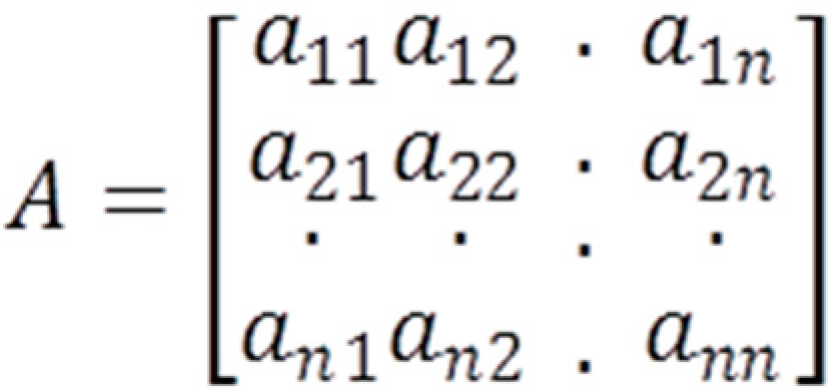
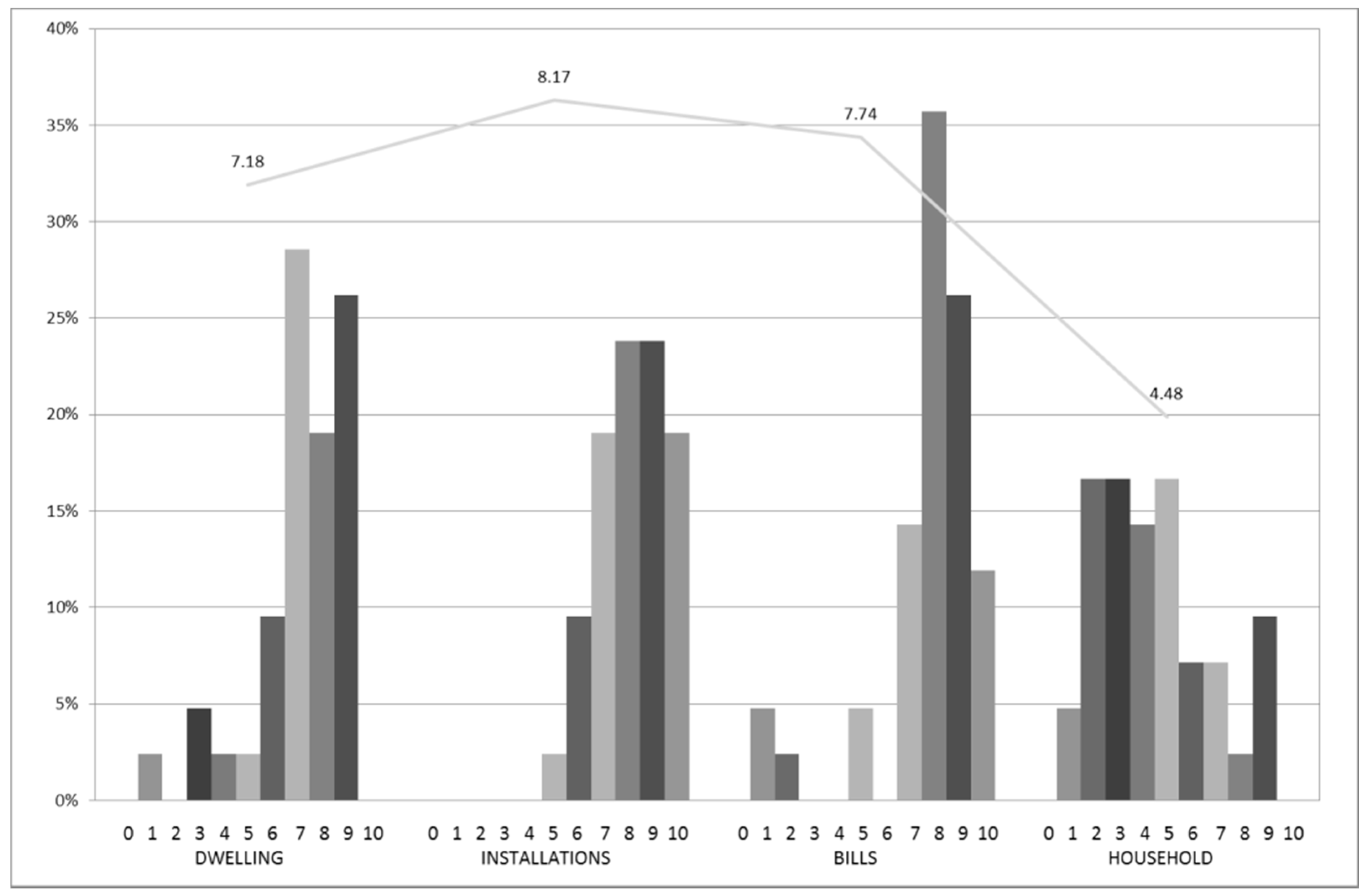
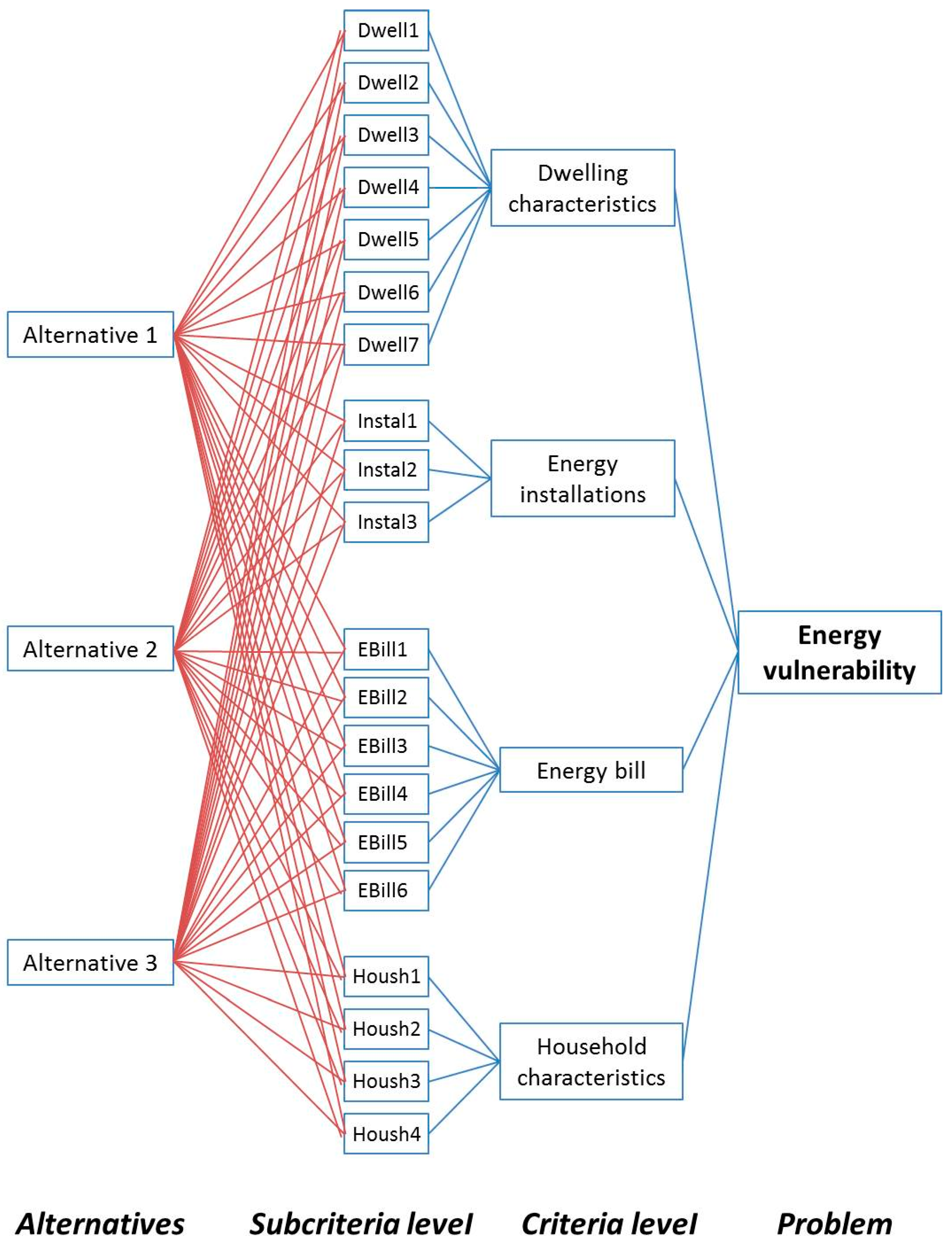









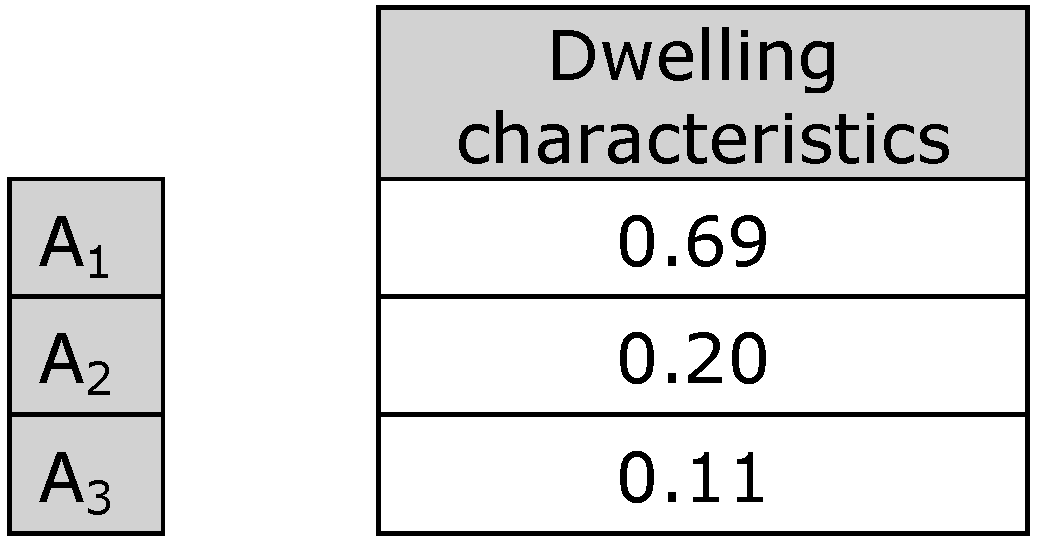



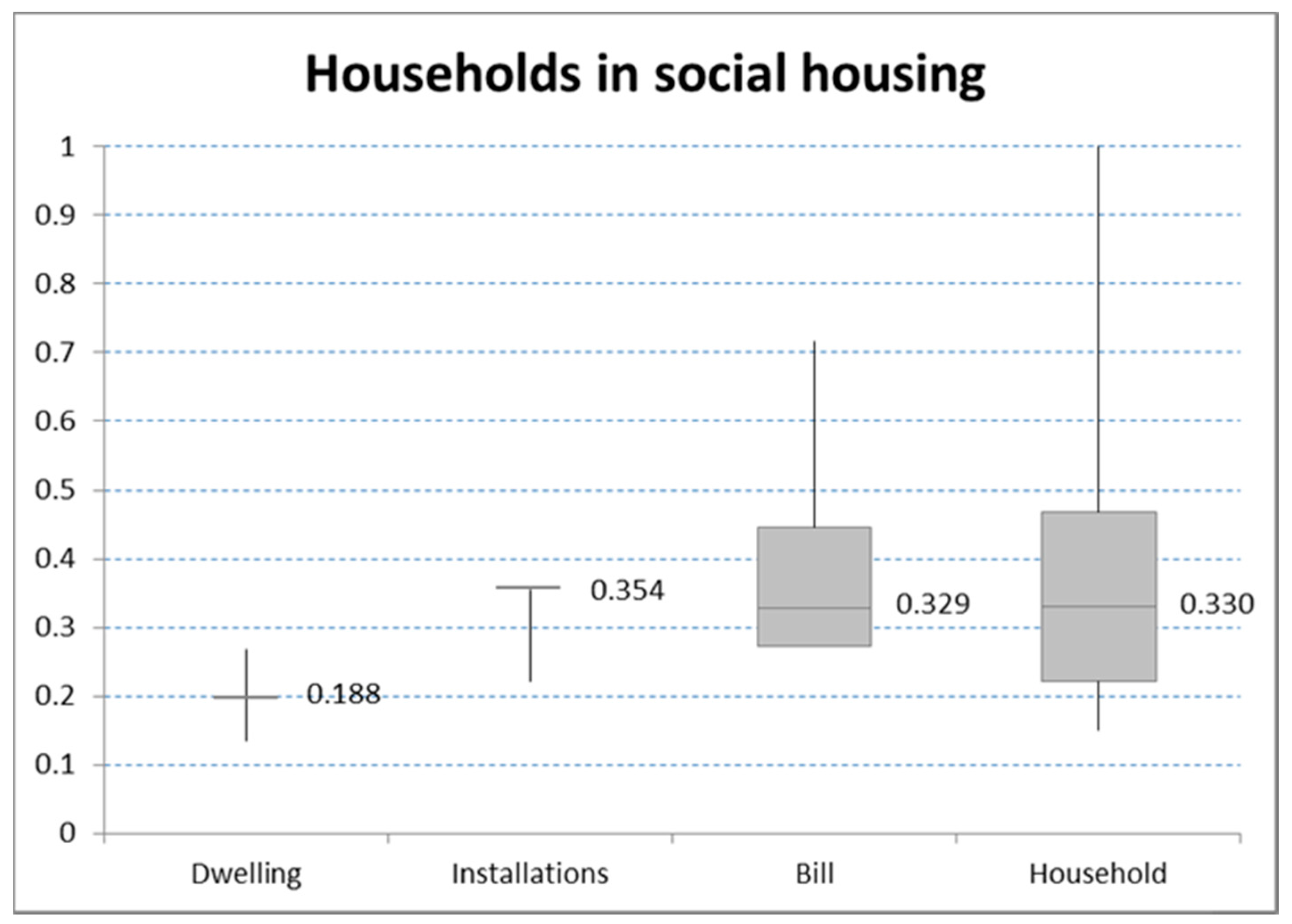
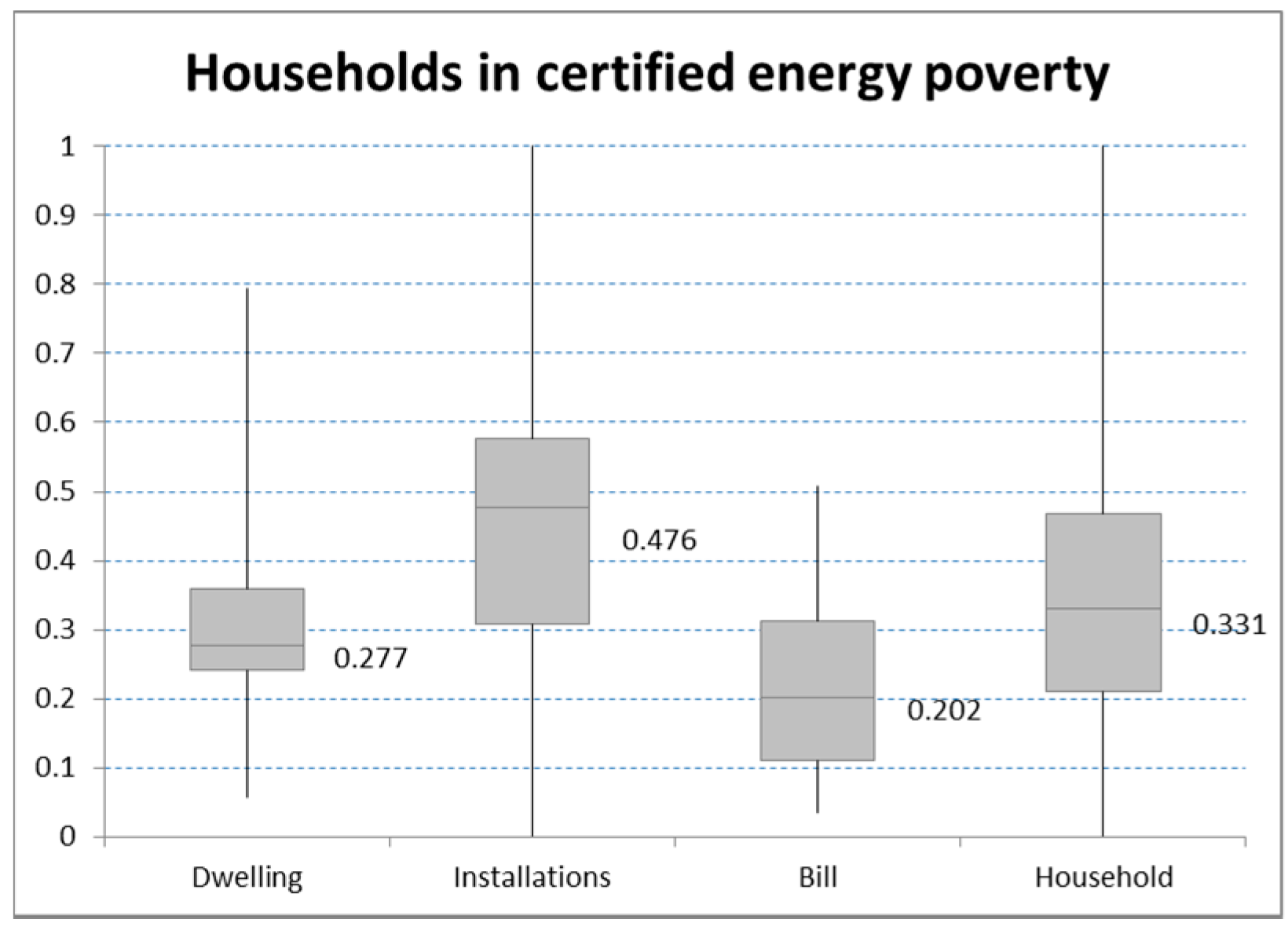
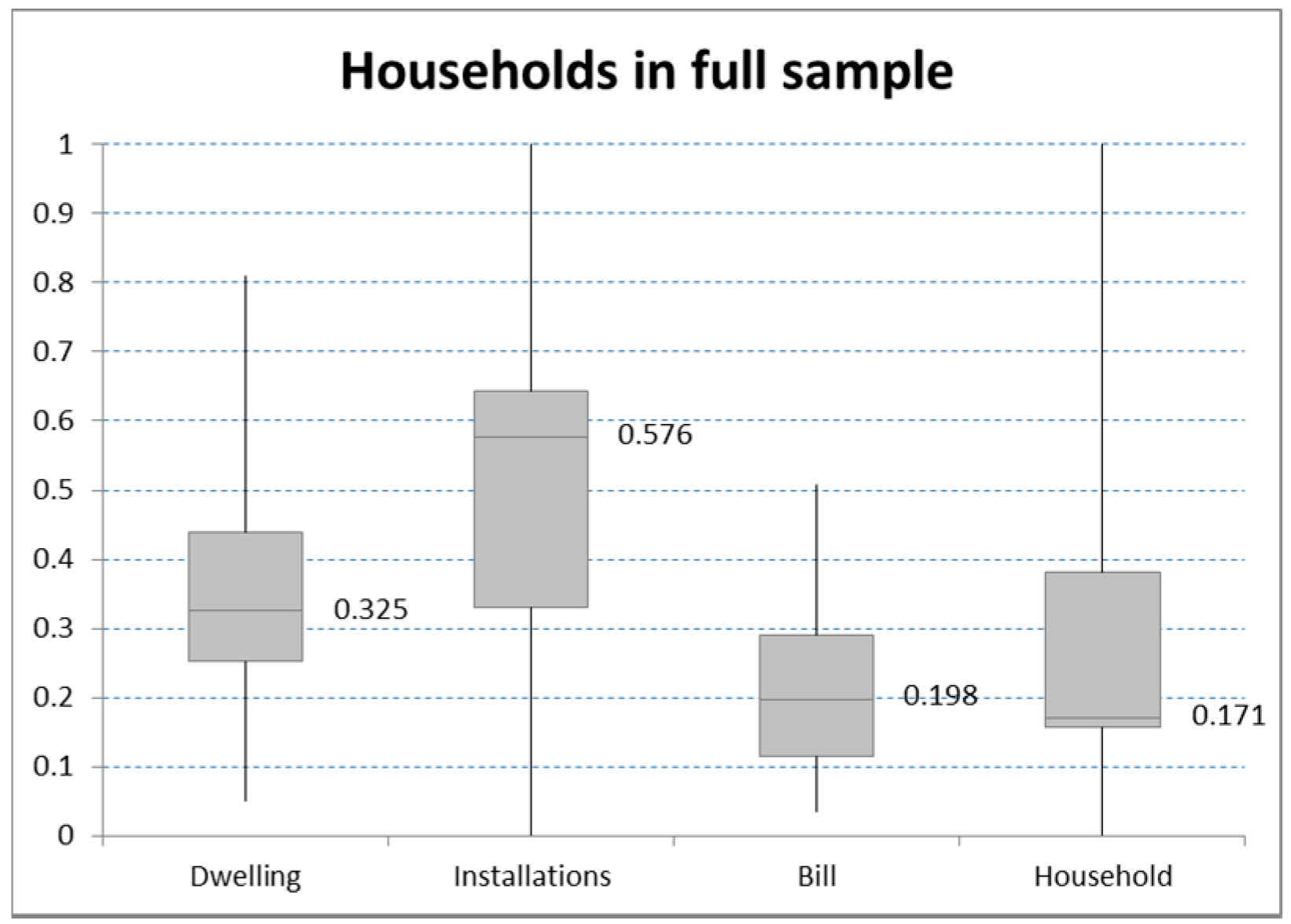
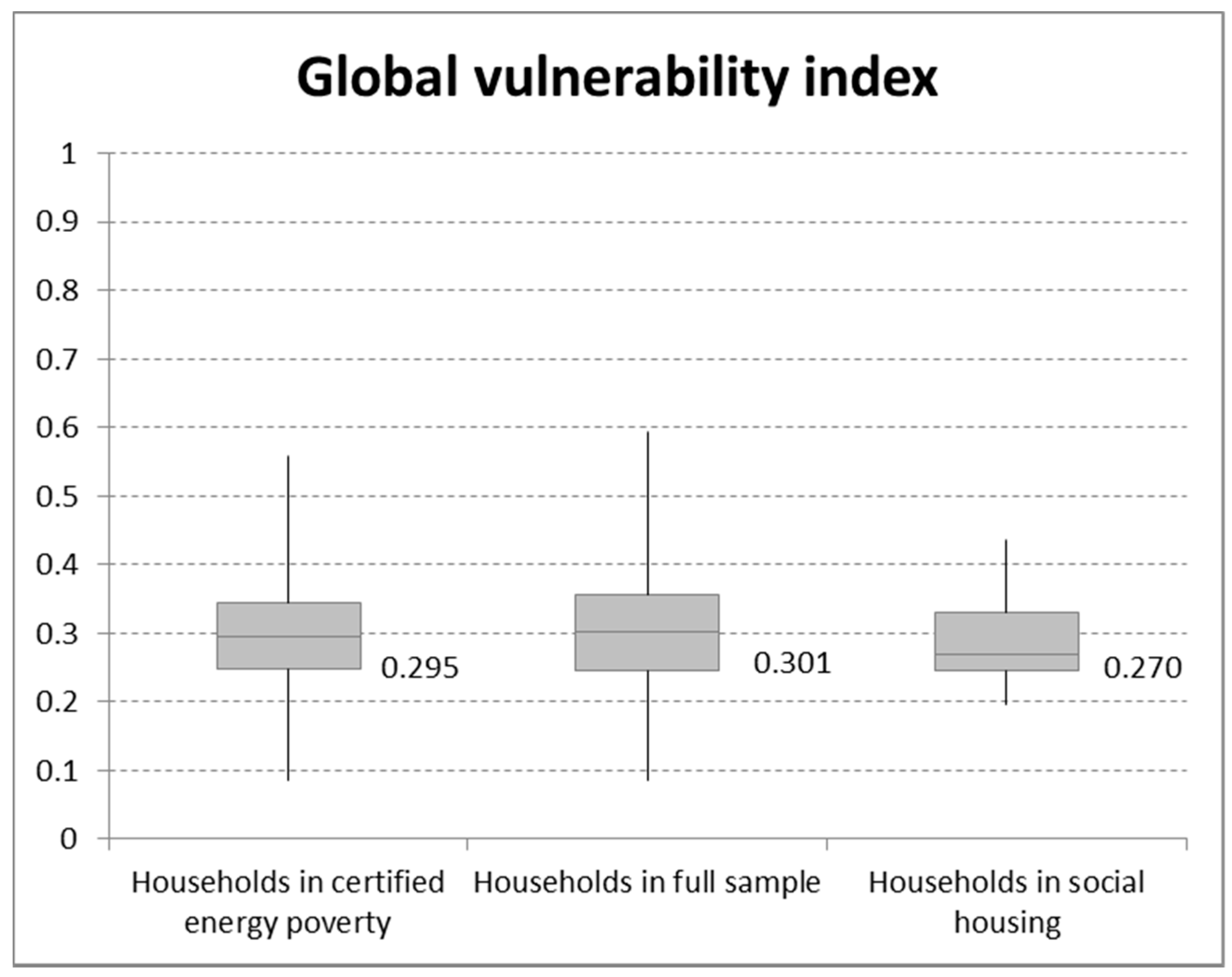
| Variable | Description of Variable | Factor |
|---|---|---|
| Dwell 1 | Geographical area in which the building is located | Dwelling characteristics |
| Dwell 2 | Environment surrounding the building (urban/rural) | Dwelling characteristics |
| Dwell 3 | Year of construction of the building | Dwelling characteristics |
| Dwell 4 | Ownership | Dwelling characteristics |
| Dwell 5 | Type of residence | Dwelling characteristics |
| Dwell 6 | Size | Dwelling characteristics |
| Dwell 7 | Number of rooms | Dwelling characteristics |
| Instal 1 | Is the home equipped with heating equipment? | Energy installations |
| Instal 2 | Main type of heating in use | Energy installations |
| Instal 3 | Is the home equipped with air conditioning? | Energy installations |
| Ebill 1 | Voltage supplied | Energy bill |
| Ebill 2 | Is the voltage supplied known by household members? | Energy bill |
| Ebill 3 | Electric tariff applied | Energy bill |
| Ebill 4 | Is the electric tariff applied known by household members? | Energy bill |
| Ebill 5 | Energy expense | Energy bill |
| Ebill 6 | Expense of other energy sources | Energy bill |
| Househ 1 | Social service aid | Characteristics of the household |
| Househ 2 | Household income | Characteristics of the household |
| Househ 3 | Number of household members | Characteristics of the household |
| Househ 4 | Number of minors in the household | Characteristics of the household |
| Average | Relative Importance for Vulnerability | |
|---|---|---|
| Dwelling | 7.18 | 26% |
| Installations | 8.17 | 30% |
| Bill | 7.74 | 28% |
| Household | 4.48 | 16% |
| Alternatives | Dwell 1 | Dwell 2 | Dwell 3 | Dwell 4 | Dwell 5 | Dwell 6 | Dwell 7 | |
|---|---|---|---|---|---|---|---|---|
| A1 | Totally vulnerable household | 3 | 1 | 1 | 3 | 1 | 4 | 5 |
| A2 | Subject household | 1 | 1 | 0 | 2 | 0 | 2 | 1 |
| A3 | Zero vulnerability household | 1 | 0 | 0 | 1 | 0 | 1 | 1 |
| IVI Regarding Dwelling Characteristics | IVI Regarding Energy Installation | IVI Regarding Energy Bill | IVI Regarding Household Characteristics | GLOBAL VULNERABILITY |
|---|---|---|---|---|
| 0.16 | 0.35 | 0.35 | 0.15 | 0.25 |
| VI | |
|---|---|
| Low | 0–0.25 |
| Moderate | 0.25–0.50 |
| High | 0.50–0.75 |
| Very high | 0.75–1 |
© 2017 by the authors. Licensee MDPI, Basel, Switzerland. This article is an open access article distributed under the terms and conditions of the Creative Commons Attribution (CC BY) license (http://creativecommons.org/licenses/by/4.0/).
Share and Cite
Llera-Sastresa, E.; Scarpellini, S.; Rivera-Torres, P.; Aranda, J.; Zabalza-Bribián, I.; Aranda-Usón, A. Energy Vulnerability Composite Index in Social Housing, from a Household Energy Poverty Perspective. Sustainability 2017, 9, 691. https://doi.org/10.3390/su9050691
Llera-Sastresa E, Scarpellini S, Rivera-Torres P, Aranda J, Zabalza-Bribián I, Aranda-Usón A. Energy Vulnerability Composite Index in Social Housing, from a Household Energy Poverty Perspective. Sustainability. 2017; 9(5):691. https://doi.org/10.3390/su9050691
Chicago/Turabian StyleLlera-Sastresa, Eva, Sabina Scarpellini, Pilar Rivera-Torres, Juan Aranda, Ignacio Zabalza-Bribián, and Alfonso Aranda-Usón. 2017. "Energy Vulnerability Composite Index in Social Housing, from a Household Energy Poverty Perspective" Sustainability 9, no. 5: 691. https://doi.org/10.3390/su9050691
APA StyleLlera-Sastresa, E., Scarpellini, S., Rivera-Torres, P., Aranda, J., Zabalza-Bribián, I., & Aranda-Usón, A. (2017). Energy Vulnerability Composite Index in Social Housing, from a Household Energy Poverty Perspective. Sustainability, 9(5), 691. https://doi.org/10.3390/su9050691







